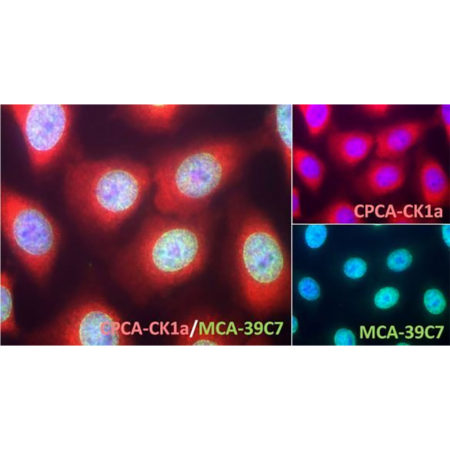| Name: | Chicken Polyclonal to Casein Kinase 1 alpha |
| Immunogen: | Recombinant full length CK1a (shortest isoform) |
| HGNC Name: | CSNK1A1 |
| UniProt: | |
| Molecular Weight: | 38kDa |
| Host: | Chicken |
| Isotype: | IgY |
| Species Cross-Reactivity: | Human, rat, mouse, horse, cow, pig, chicken |
| RRID: | AB_2572248 |
| Format: | Antibody is supplied as an aliquot of concentrated IgY preparation. |
| Applications: | WB, ICC/IF, IHC |
| Recommended Dilutions: | WB: 1:10,000 IF: 1:500-1:1000 ABC: 1:5,000 |
| Storage: | Shipped on ice. Store at 4°C. For long term storage, leave frozen at -20°C. Avoid freeze / thaw cycles. |
Casein Kinase 1α, chicken polyclonal
Cat# CPCA-CK1α
$120.00 – $800.00
Many serine threonine (ser/thr) protein kinases are activated by specific small signalling molecules such as calcium, cAMP, cGMP while others appear to be cofactor independent. The casein kinases belong to this group, and how their activity is regulated is still something of a mystery (1,2). There are two broad families of these kinases called CKI and CKII (or CK1 and CK2). They were originally isolated since extracts of most cells contain two distinct fractions of kinase activity both of which are able to phosphorylate the milk protein casein. It is now known that the CKI and CKII activities represent two different families of distinct kinases, each consisting of several different gene products. The different proteins clearly represent an ancient and unusually conserved family of kinases, sharing some unique sequence characteristics not found in other protein kinases. The CKI family consists of several different genes, divided in α, β, γ, δ and ε (alpha, beta, gamma, delta and epsilon), some of which are encoded by more than one gene. The single mammalian CK1α gene can generate four different proteins by altering transcription. The CK1 alpha proteins are involved in the control of protein degradation, and phosphorylate acidic regions of their substrate molecules. Typically the target Ser/Thr residues closely C-terminal to two or three Asp or Glu acid residues. Alternately, phosphorylation on residues 3 or 4 amino acids N-terminal to a Ser/Thr residue can also favor CKI phosphorylation. This means that CKI family enzymes often phosphorylate one or more Ser/Thr residues C-terminal to a phosphorylation site generated by the activity of another protein kinase.
This antibody was made against a recombinant construct based on the smallest CKIα isotype and will therefore bind to all CKIα isotypes.
Many serine threonine (ser/thr) protein kinases are activated by specific small signalling molecules such as calcium, cAMP, cGMP while others appear to be cofactor independent. The casein kinases belong to this group, and how their activity is regulated is still something of a mystery (1,2). There are two broad families of these kinases called CKI and CKII (or CK1 and CK2). They were originally isolated since extracts of most cells contain two distinct fractions of kinase activity both of which are able to phosphorylate the milk protein casein. It is now known that the CKI and CKII activities represent two different families of distinct kinases, each consisting of several different gene products. The different proteins clearly represent an ancient and unusually conserved family of kinases, sharing some unique sequence characteristics not found in other protein kinases.
The CKI family consists of several different genes, divided in alpha, beta, gamma, delta and epsilon, some of which are encoded by more than one gene. The single mammalian CK1 alpha gene can generate four different proteins by altering transcription. CPCA-CK1a was raised against the shortest of these proteins, and will therefore bind to all CK1 isotypes.
The CK1 alpha proteins are involved in the control of protein degradation, and phosphorylate acidic regions of their substrate molecules. Typically the target Ser/Thr residues closely C-terminal to two or three Asp or Glu acid residues. Alternately, phosphorylation on residues 3 or 4 amino acids N-terminal to a Ser/Thr residue can also favor CKI phosphorylation. This means that CKI family enzymes often phosphorylate one or more Ser/Thr residues C-terminal to a phosphorylation site generated by the activity of another protein kinase.
1. Knippschild U, Gocht A, Wolff S, Huber N, Lohler J, Stoter M. The casein kinase 1 family: participation in multiple cellular processes in eukaryotes. Cell Signal. 17:675-89 (2005)
2. Vielhaber E and Virshup DM. Casein kinase I: from obscurity to center stage. IUBMB Life 51:73-8 (2001).
3. Kuret J, Johnson GS, Cha D, Christenson ER, DeMaggio AJ, Hoekstra MF. Casein kinase 1 is tightly associated with paired-helical filaments isolated from Alzheimer’s disease brain. J Neurochem. 69:2506-15 (1997).
4. Dupre-Crochet S, Figueroa A, Hogan C, Ferber EC, Bialucha CU, Adams J, Richardson EC, and Fujita Y. Casein Kinase 1 Is a Novel Negative Regulator of E-Cadherin-Based Cell-Cell Contacts. Molecular and Cellular Biology Volume 27:3804-3816 (2007).
Contact info
EnCor Biotechnology Inc.
4949 SW 41st Boulevard, Ste 40
Gainesville
Florida 32608 USA
Phone: (352) 372 7022
Fax: (352) 372 7066
E-mail: admin@encorbio.com



